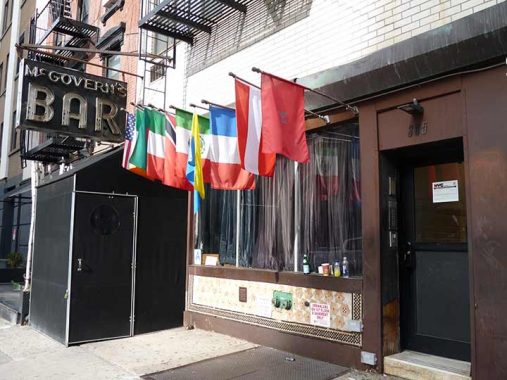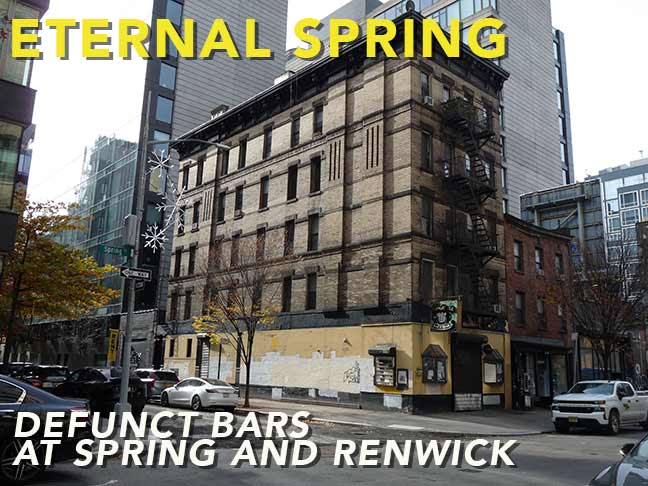
JUST a quick one this week, as I will be occupied much of Easter Sunday and I am busy assembling the FNY 25th anniversary event presentation scheduled for Thursday, April 18, 7PM, Bayside Historical Society in Fort Totten (get your ticket now!). I also have to decide on a venue for FNY’s first live tour since November 2019, which will be a Jane’s Walk event the first weekend in May; details will be forthcoming. Additionally I do freelance editing for my employer Marquis Who’s Who a few hours each weekend, because I need the ca$h. So, the plate is full.
I was on my way to photograph Worth Street from west to east for an FNY Crosstown post, and felt like a bit of walking beforehand, so I got off the train at Spring Street and made my way west and south. It occurred to me that I hadn’t really inspected Renwick Street, a “One and Done” between Spring and Canal west of Hudson, since my original post in 2008, so I decided to visit.
Two classic neon signs face off at Spring and Renwick, each for long-defunct bars. A few weeks ago, I rewatched Martin Scorsese’s “After Hours” in which an office jockey played by Griffin Dunne has a night he’ll never forget in Soho. At one point he winds up in a place called the Terminal Bar where the bartender was played by the late great John Heard. (Dunne and Heard had previously starred together in the Canadian indie film “Head Over Heels,” in which Heard gets into an unfortunate relationship; ditto for Dunne in “After Hours.”) The Terminal Bar was, in turn, played by the Emerald Inn, in. a very old building at Spring and Renwick, which was in business from 1972 to 2015. amazingly, its classic neon sign with a neon harp is still hanging outside, waiting for the day, perhaps, when it will be in business again.

Given all the flags on the exterior, there’s something going on at #307 Spring, opposite the Emerald. The old McGovern’s Bar sign from years ago is still there. In a printed piece I read recently a waitress recalled that the former clientele was “longshoremen and printers,” both professions keeping late hours. There were probably also firemen from what is now the nearby FDNY Museum. McGoverns was a neighborhood bar with live music acts. It later became Sway, a velvet rope-type joint.
Forgotten Fan Alec Cumming (who played in a band called Bite the Wax Godhead, which appeared at McGovern’s) recalls:
It was a dive bar, run by a fun if rougeish guy named Steve… whom I believe ran into tax trouble which led to the closing of the bar (in the late ’90s?) It had free admission and a free-willing, “we’re so unhip we’re hip” atmosphere, and so often the bands were experimental, or tuneful, or wacky, or all of the three. There was a busy table and at least one pinball machine..
Actor Michael Imperioli (“The Sopranos”) also recalls McGovern’s in this interview.

Speaking of “After Hours,” #305 Spring, left, was where the Terminal Bar waitress Cindy, played by Terri Garr, unsuccessfully tries to seduce Dunne’s character.
Before there were such things as street signs, the main street identifiers were chiseled signs on buildings, like this one at Spring and Greenwich–some building owners provided them, some didn’t. Up the street is the only bar on this stretch of Spring still in business, the Ear Inn.
The Ear Inn, #326 Spring, is located in a house built by tobacco trader James Brown, who, according to legend was the Black man pictured in Emanuel Leutze’s picture of Washington Crossing the Delaware. By the 1850s the place was a brewery in which drinks were served to local stevedores and dock workers; it has more or less filled that function for the next 150 years and counting.
In the 1890s Irish immigrant Thomas Cloke purchased 324 and 326 Spring Street and set up a liquor distributorship. Cloke and his brother Patrick bottled corn whisky in the basement and brewed beer in the back yard. He also set up a public house where food and drinks were served to passengers and crew of ships docking nearby on the Hudson River. Cloke’s sign hung above 326 Spring for nearly four decades.
When the 18th Amendment was passed, outlawing the sale of liquor in 1919, Cloke leased the business to a John Rolandi, who ostensibly ran the place as a restaurant, with a speakeasy in the back room behind a curtain. When the Holland Tunnel was built in the mid-1920s, 326 Spring did a handsome trade serving lunch, and other ingestibles, to construction workers.
They have an excellent hamburger. The neon sign dates to the 1940s; in the 1970s, owner Rip Hayman, rather than deal with the red tape required by the Landmarks Preservation Commission to alter the exterior, painted out half the “b” in “BAR” and presto, the Ear. Here’s #326 Spring in 1940.
From the looks of things, #310 Spring appears to be a very old building, and Tom Miller, the indefatigable Daytonian in Manhattan, confirms that it was built in 1819, rivaling the James Brown House where the Ear Inn is located. It was buildit by Captain Dennison Wood of the cargo sailing ship the Levant and later, the Louisa Matilda. Both ships carried fgoods to and from Savannah, GA.
I spoke to soon abou the Ear being the only place to get a drink on western Spring Street. #310 is home to Lazy Point, which has a different vibe from the Ear; one reviewer says, “Tucked away in Hudson Square, this bar feels as though you have stepped off Manhattan and wandered into a little slice of beach life heaven!”


Renwick Street was named for author/engineer/scientist James Renwick (1792-1863), a Professor of Natural and Experimental Philosophy at Columbia College, which was located downtown a few blocks from Renwick’s namesake street at the time . Since Renwick Stret begins showing up on NYC maps in the late 1830s or early 1840s, the street was named for Renwick when he was still alive — quite a tribute. Renwick’s son James Jr. became an architect; he was the mastermind behind St. Patrick’s Cathedral, Smithsonian Institution, as well as the magnificent ruin of Roosevelt Island, the Smallpox Hospital, as well as the lighthouse at the northern end of the island.
Renwick Street features a couple of newer high rise apartments whose construction was advertised on the 2008 page linked above, but my interest lies in the older buildings shown here, two walkup apartment buildings and what appears to be an early 20th Century office building in buff bricks. Renwick is not in a landmarked district, and its buildings haven’t been investigated as thoroughly at least sufficiently to be included in a Landmarks Preservation Commission report. Old maps, too, are quiet about the various purposes these buildings had.

This loft building, at the SW corner of Renwick and Canal, has what architects call a “chamfered” corner, a straight edge to avoid a sharp angle. In older photos, the Benjamin Moore Paints logo appears at the roofline, so this may be a former factory where the paints were made.
I have to get outta here, but this walk produced more images on Hudson and Worth Streets which will soon appear on your Forgotten NY.
As always, “comment…as you see fit.” I earn a small payment when you click on any ad on the site. Take a look at the new JOBS link in the red toolbar at the top of the page on the desktop version, as I also get a small payment when you view a job via that link.
3/31/24



2 comments
This is fascinating! I never heard of Renwick Street. Thank you for this great article
I would be absolutely thrilled to attend the first FNY tour since ’19 however I will be participating in the TD Five Boro Bike Tour on May 5th. If there is any way to schedule this first new FNY tour around this, either for saturday the 4th or the following weekend, I would be infinitely thankful. I look forward for the announcement of details on the new tours in any case.